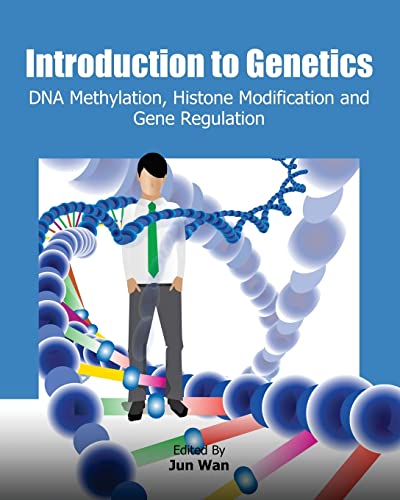Items related to Introduction to Genetics: DNA Methylation, Histone...

DNA methylation is the modification of DNA molecule, transferring methy group to the 5th position of the cytosine pyrimidine ring. This biochemical process plays a crucial role in many cellular processes of higher organisms. For example, people have found distinct patterns of DNA methylation during cellular differentiation and tissue development. The differential DNA methylation profiles are often associated with gene expression. In addition, DNA methylation reveals genomic imprinting and affects on chromatin remodeling and cellular homeostasis. Such epigenetic modification has also been proven to be involved in nearly all cancer-related signaling pathways. However, the mechanism and process against how DNA methylation regulates gene expression are still not clear. The study of DNA methylation and its regulation on gene expression provides fundamental and new insights into the genetic heritability. In Chapter 1, Gene duplication event of NAC transcription factor genes in rice and Arabidopsis was analyzed, then it was found that chromosomal segment duplications mainly contributed to the expansion of both species, whereas tandem duplication occurred less frequently in Arabidopsis than rice. Chapter 2 reviews the current literature related to the epigenetics of alcoholism and summarizes our advanced study of global DNA methylation in human post-mortem frontal cortex tissues obtained from adult alcoholics and controls utilizing new microarray technology and bioinformatics approaches. Chapter 3 gives a comprehensive synopsis over the epigenetic modifications involved in the regulation of bacterial gene expression as well as the patho-epigenetic modifications in eukaryotic host tissues triggered in the pathogenesis of particular Gram-negative bacterial infections. Both, basic molecular mechanisms and complex pathogenetic relations are described. Chapter 4 provides an epigenetic repressing mechanism for breast cancer metastasis by recruiting NuRD complex to ESR1 gene through TWIST1. Chapter 5 summarises most of mouse models that have helped us better understand the pathogenesis mechanism during the development of colitis. In Chapter 6, the authors review the various forms of presentation of celiac disease including the lymphocytic enteritis, along with their systemic manifestations. Chapter 7 provides an insight to inflammatory response in light of DNA regulation and methylation of key players. Because chronic inflammatory diseases do share common features, recent progress in our understanding of renal fibrosis and inflammation in chronic kidney disease will be discussed as an example of epigenetic regulation in inflammatory diseases. Chapter 8 summarizes the regulation of gene expression in pterygium. Pterygium is an ocular surface disease and its pathogenesis is currently unknown. Here, the genetic and epigenetic changes in the disease are explored. Chapter 9 summaries the basics and applications of recently proposed MiRaGE method that infer miRNA-mediated regulation of target genes and miRNA-targeting-specific promoter methylation. The applications to differentiation, cell senescence, and miRNA transfection to lung cancer celll lines are discussed. Chapter 10 proposes the role of AP-1 chromatin modulator Jun dimerization protein 2 (JDP2) on antioxidant response and inhibition of ROS production via Nrf2-ARE signaling, as well as the induction of replicative senescence. Chapter 11 compares expression profiles of mRNAs, microRNAs and proteins of human embryonic stem cells hES-T3 grown on different feeders and conditioned media. Chapter 12 reviews the most recent molecular markers of Amyotrophic Lateral Sclerosis (ALS) and shows some innovative perspectives on this topic from the point of view of gene therapy. In addition, non-viral gene therapy based on the non-toxic C-terminal fragment of the tetanus toxin (TTC) will also be discussed.
"synopsis" may belong to another edition of this title.
- PublisherCreateSpace Independent Publishing Platform
- Publication date2013
- ISBN 10 1477554947
- ISBN 13 9781477554944
- BindingPaperback
- Number of pages270
Buy New
Learn more about this copy
US$ 95.00
Shipping:
FREE
Within U.S.A.
Top Search Results from the AbeBooks Marketplace
Introduction to Genetics: DNA Methylation, Histone Modification and Gene Regulation
Published by
CreateSpace Independent Publishing Platform
(2013)
ISBN 10: 1477554947
ISBN 13: 9781477554944
New
Softcover
Quantity: > 20
Seller:
Rating
Book Description Condition: New. Print on Demand. Seller Inventory # I-9781477554944
Buy New
US$ 95.00
Convert currency
Introduction to Genetics: DNA Methylation, Histone Modification and Gene Regulation
Published by
Createspace Independent Publishing Platform
(2013)
ISBN 10: 1477554947
ISBN 13: 9781477554944
New
Paperback / softback
Quantity: > 20
Seller:
Rating
Book Description Paperback / softback. Condition: New. This item is printed on demand. New copy - Usually dispatched within 5-9 working days. Seller Inventory # C9781477554944
Buy New
US$ 108.31
Convert currency

